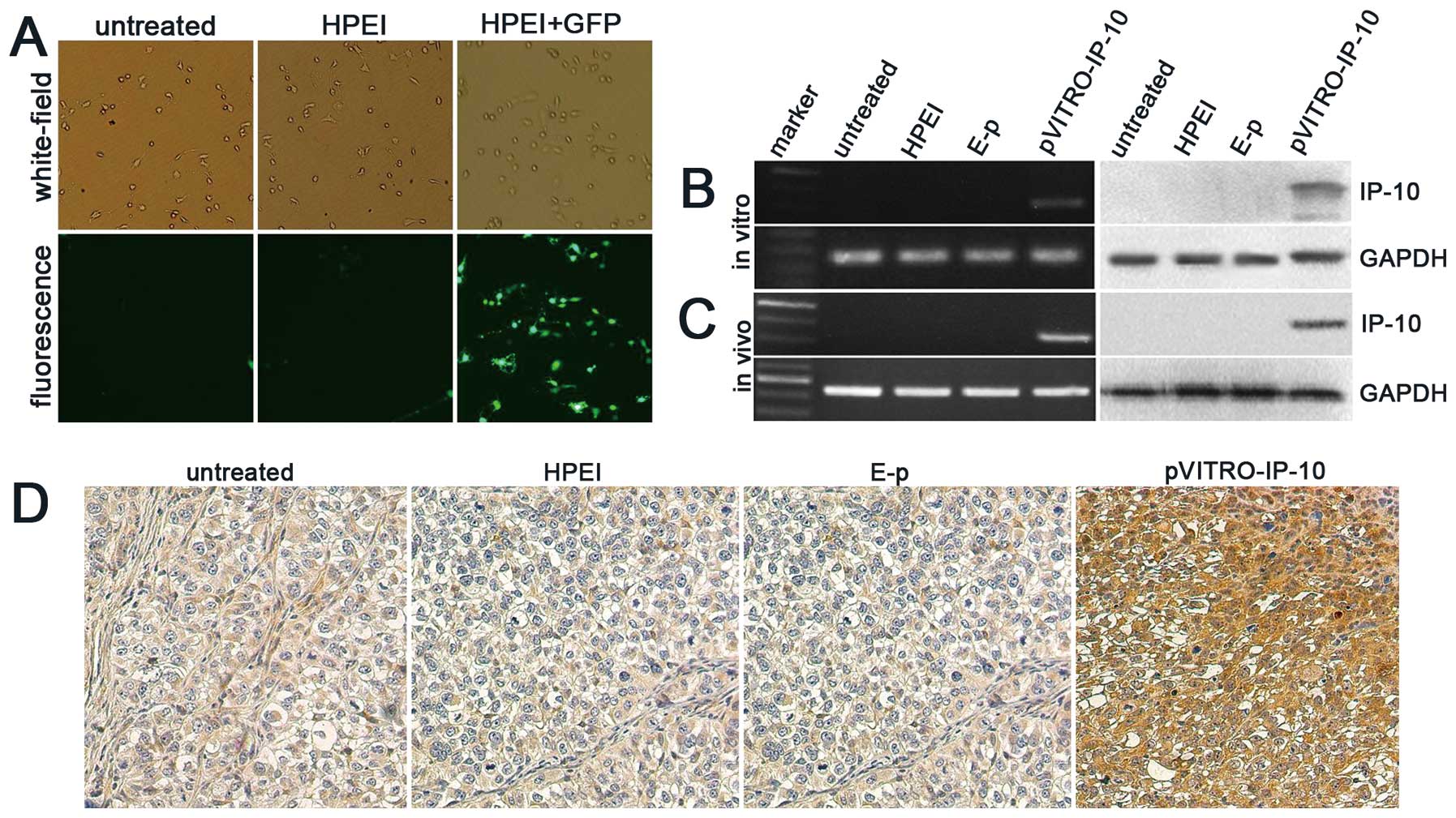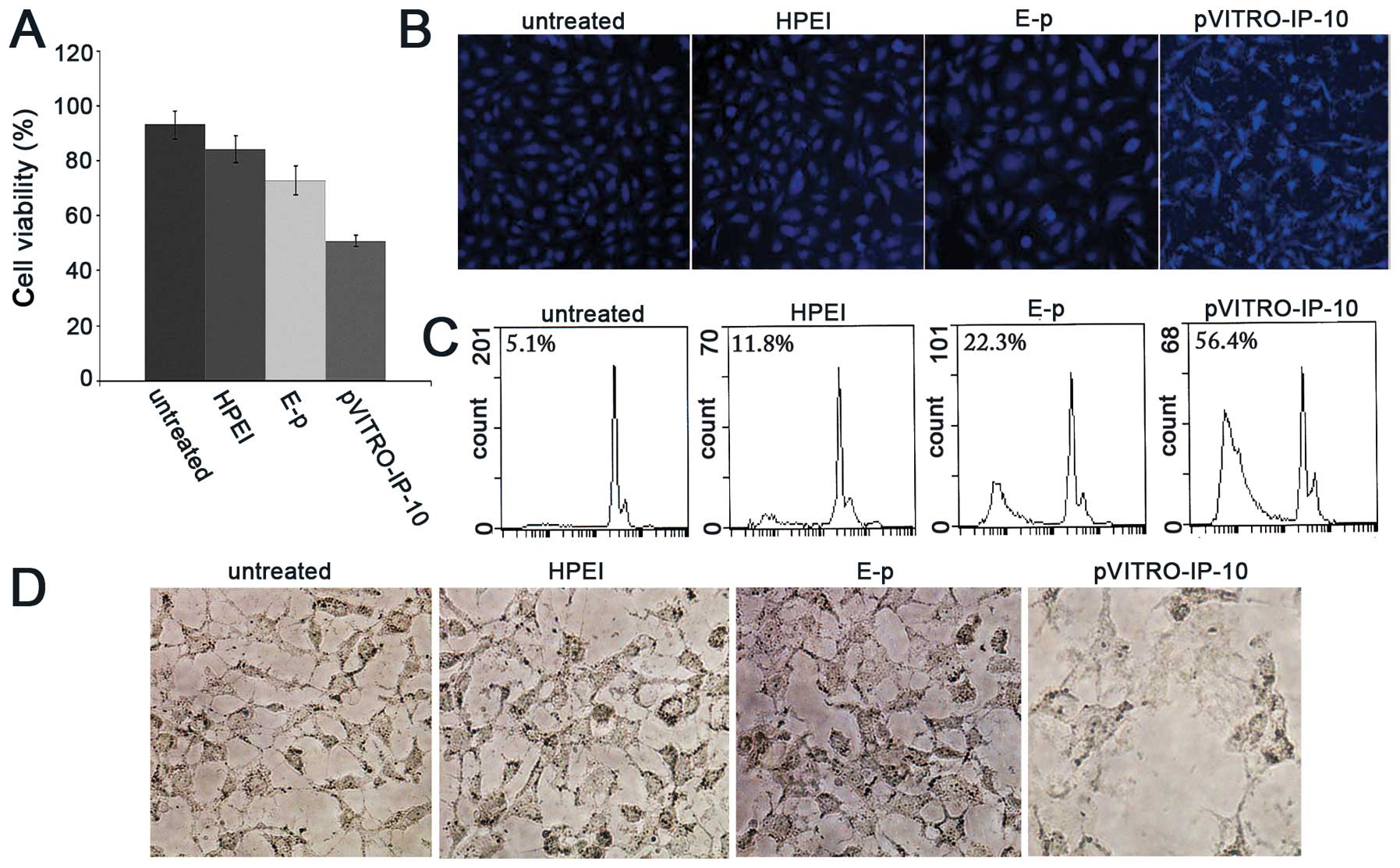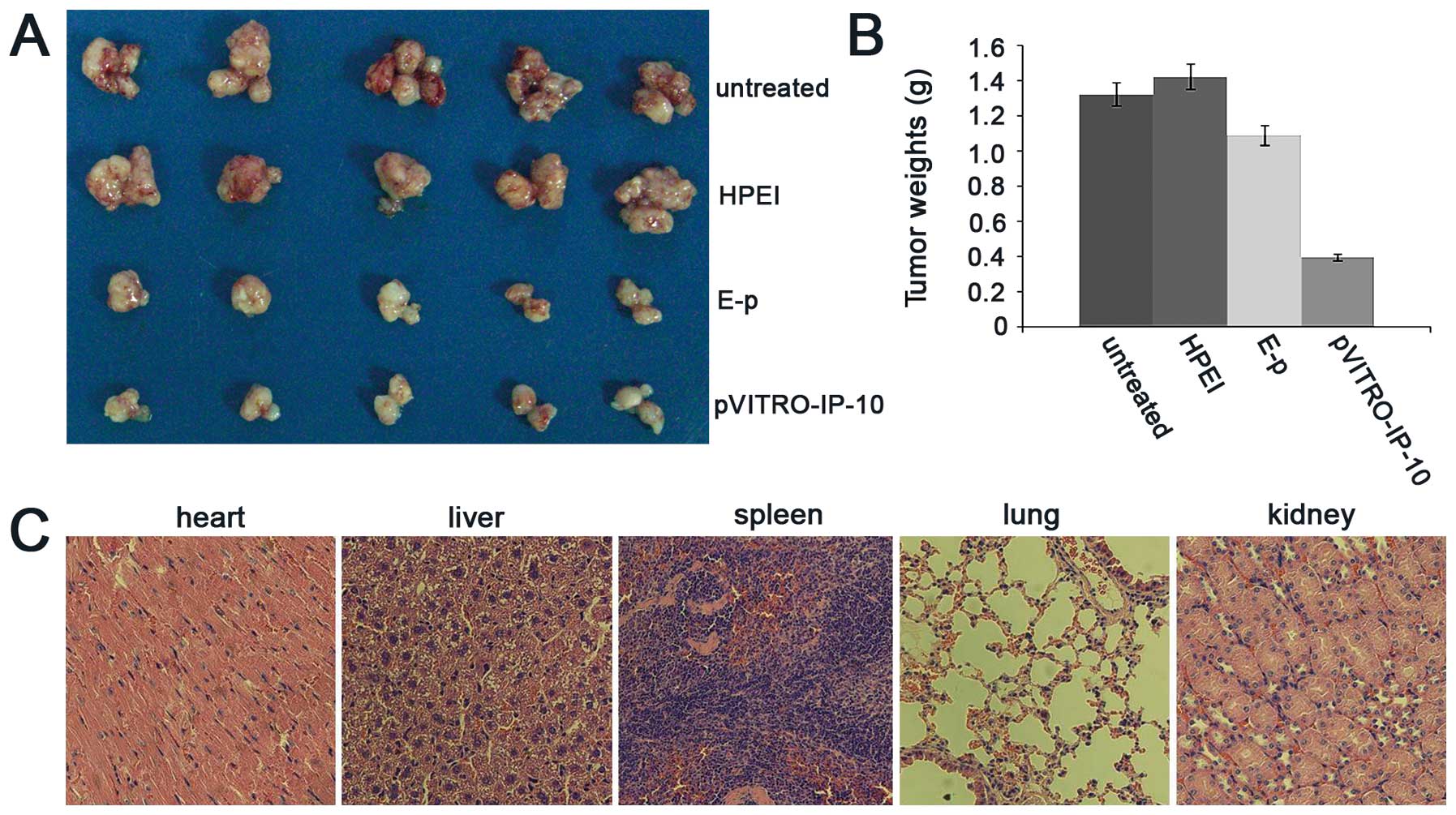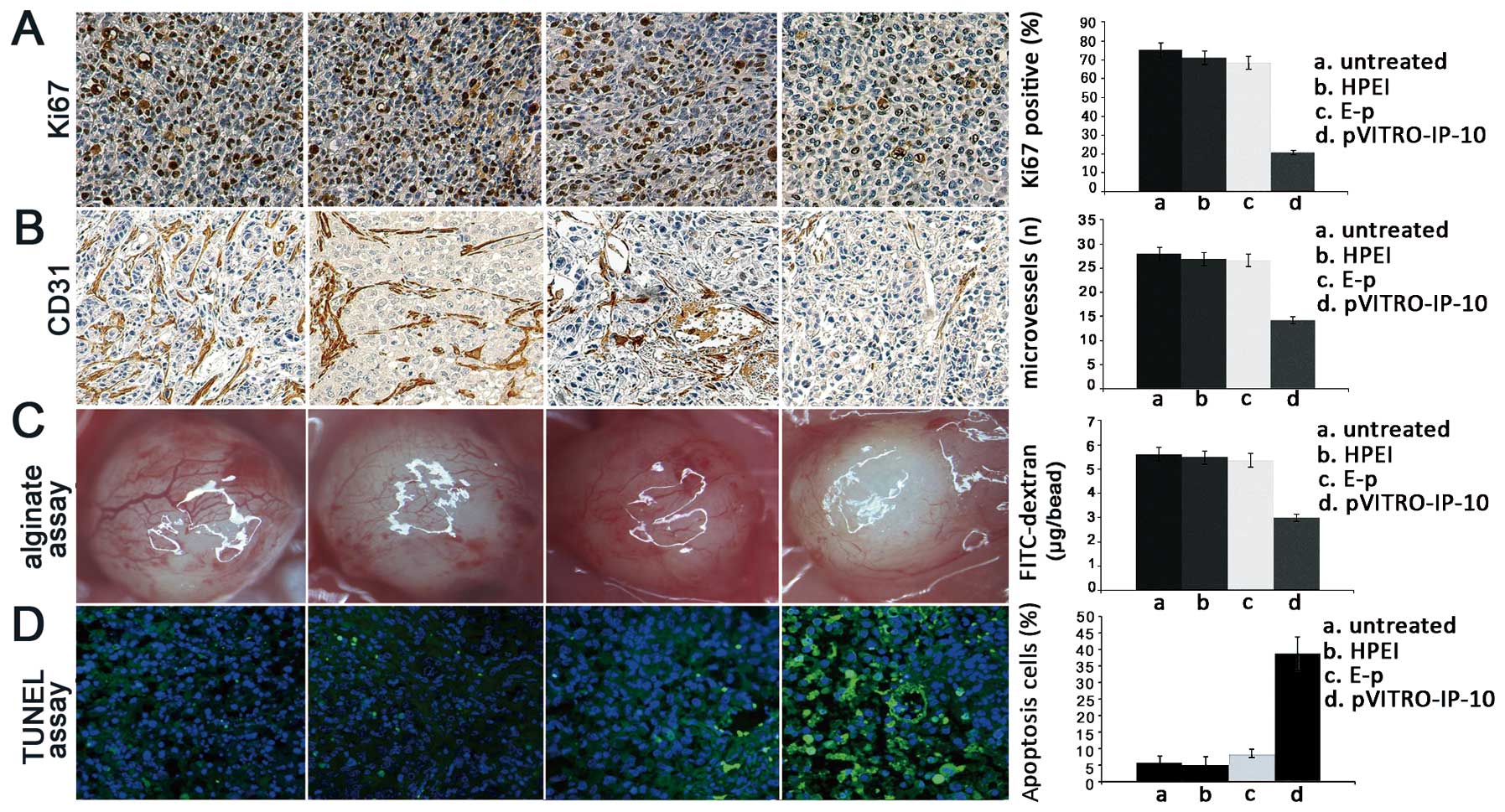|
1
|
Jermal A, Siegel R, Xu J and Ward E:
Cancer statistics, 2010. CA Cancer J Clin. 60:277–300. 2010.
View Article : Google Scholar
|
|
2
|
Jemal A, Siegel R, Ward E, Hao Y, Xu J and
Thun MJ: Cancer statistics, 2009. CA Cancer J Clin. 59:225–249.
2009. View Article : Google Scholar
|
|
3
|
DiSaia PJ and Creasman WT: Epithelial
ovarian cancer. Clinical Gynecologic Oncology. 5th edition.
1997
|
|
4
|
Farber J and Mig M: IP-10: CXC chemokines
that target lymphocytes. J Leukoc Biol. 61:246–247. 1997.PubMed/NCBI
|
|
5
|
Loetscher M, Loetscher P, Brass N, Meese E
and Moser B: Lymphocyte-specific chemokine receptor CXCR3:
regulation, chemokine binding and gene localization. Eur J Immunol.
28:3696–3705. 1998. View Article : Google Scholar : PubMed/NCBI
|
|
6
|
Neville LF, Mathiak G and Bagasra O: The
immunobiology of interferon-gamma inducible protein 10 kD (IP-10):
a novel, pleiotropic member of the CXC chemokine superfamily.
Cytokine Growth Factor Rev. 8:207–219. 1997. View Article : Google Scholar : PubMed/NCBI
|
|
7
|
Douglas A, Arenberg A, Steven LK and
Unkelfl PJ: Cisplatin-based adjuvant chemotherapy in patients with
completely resected non-small-cell lung cancer. N Engl J Med.
350:351–360. 2004. View Article : Google Scholar : PubMed/NCBI
|
|
8
|
Maru SV, Holloway KA, Flynn G, Lancashire
CL, Loughlin AJ, Male DK and Romero IA: Chemokine production and
chemokine receptor expression by human glioma cells: role of CXCL10
in tumour cell proliferation. J Neuroimmunol. 199:35–45. 2008.
View Article : Google Scholar : PubMed/NCBI
|
|
9
|
Fujita M, Zhu X, Ueda R, Sasaki K,
Kohanbash G, Kastenhuber ER, McDonald HA, Gibson GA, Watkins SC and
Muthuswamy R: Effective immunotherapy against murine gliomas using
type 1 polarizing dendritic cells - significant roles of CXCL10.
Cancer Res. 69:1587–1595. 2009. View Article : Google Scholar
|
|
10
|
Strieter RM, Polverini PJ, Kunkel SL, et
al: The functional role of the ELR motif in CXC chemokine mediated
angiogenesis. J Biol Chem. 270:348–357. 1995. View Article : Google Scholar : PubMed/NCBI
|
|
11
|
Boussif O, Lezoualc'h F, Zanta MA, et al:
A versatile vector for gene and oligonucleotide transfer into cells
in culture and in vivo: polyethylenimine. Proc Natl Acad Sci USA.
92:7297–7301. 1995. View Article : Google Scholar : PubMed/NCBI
|
|
12
|
Lungwitz U, Breunig M, Blunk T and
Gopferich A: Polyethylenimine-based non-viral gene delivery
systems. Eur J Pharm Biopharm. 60:247–266. 2005. View Article : Google Scholar : PubMed/NCBI
|
|
13
|
Neu M, Fischer D and Kissel T: Recent
advances in rational gene transfer vector design based on poly
(ethyleneimine) and its derivatives. J Gene Med. 7:992–1009. 2005.
View Article : Google Scholar : PubMed/NCBI
|
|
14
|
Kunath K, Von HA, Fischer D, et al:
Low-molecular weight polyethyleneimine as a non-viral vector for
DNA delivery: comparison of physicochemical properties,
transfection efficiency and in vivo distribution with
high-molecular-weight polyethyleneimine. J Control Release.
89:113–125. 2003. View Article : Google Scholar
|
|
15
|
Gou M, Men K, Zhang J, et al: Efficient
inhibition of C-26 colon carcinoma by VSVMP gene delivered by
biodegradable cationic nanogel derived from polyethyleneimine. ACS
Nano. 4:5573–5584. 2010. View Article : Google Scholar : PubMed/NCBI
|
|
16
|
Chuan X, Ma LG, Tao Y, et al: Efficient
inhibition of ovarian cancer by truncation mutant of FILIP1L gene
delivered by novel biodegradable cationic heparin-polyethyleneimine
nanogels. Hum Gene Ther. 22:1413–1422. 2011. View Article : Google Scholar
|
|
17
|
Baudin B, Bruneel A, Bosselut N and
Vaubourdolle M: A protocol for isolation and culture of human
umbilical vein endothelial cells. Nat Protoc. 2:481–485. 2007.
View Article : Google Scholar : PubMed/NCBI
|
|
18
|
Wen Y, Wang C, Ma T, Li Z, Zhou L, Mu B,
Leng F, Shi H, Li Y and Wei Y: Immunotherapy targeting fibroblast
activation protein inhibits tumor growth and increases survival in
a murine colon cancer model. Cancer Sci. 101:2325–2332. 2010.
View Article : Google Scholar
|
|
19
|
Qiaoyun S, Andrew T, Guyen N, Angell Y, et
al: A combinatorial approach for targeted delivery using small
molecules and reversible masking to bypass non-specific uptake in
vivo. Gene Ther. 17:1085–1097. 2010. View Article : Google Scholar : PubMed/NCBI
|
|
20
|
Jen-Tsan C, Howard YC, Nancy NW, Dustin
SC, Nina D and Patrick OB: Genome wide view of gene silencing by
small interfering RNAs. Proc Natl Acad Sci USA. 11:6343–6346.
2003.PubMed/NCBI
|
|
21
|
Selvakumaran M, Pisarcik DA, Bao R, Yeung
AT and Hamilton TC: Enhanced cisplatin cytotoxicity by disturbing
the nucleotide excision repair pathway in ovarian cancer cell
lines. Cancer Res. 63:1311–1316. 2003.PubMed/NCBI
|
|
22
|
Xu GX, Zhong Y, Munir S, Yang BB, Tsang BK
and Peng C: Nodal induces apoptosis and inhibits proliferation in
human epithelial ovarian cancer cells via activin receptor-like
kinase 7. J Clin Endocrinol Metab. 89:5523–5534. 2004. View Article : Google Scholar : PubMed/NCBI
|
|
23
|
Lin XJ, Chen XC, Wei YQ, et al: Efficient
inhibition of intraperitoneal human ovarian cancer growth and
prolonged survival by gene transfer of vesicular stomatitis virus
matrix protein in nude mice. Gynecol Oncol. 104:540–546. 2007.
View Article : Google Scholar
|
|
24
|
Folkman J: Angiogenesis: an organizing
principle for drug discovery. Nat Rev Drug Discov. 6:273–286. 2007.
View Article : Google Scholar : PubMed/NCBI
|
|
25
|
Hillen F and Griffioen AW: Tumour
vascularization: sprouting angiogenesis and beyond. Cancer
Metastasis Rev. 26:489–502. 2007. View Article : Google Scholar : PubMed/NCBI
|
|
26
|
Lin XJ, Chen XC, Wang L, et al: Dynamic
progression of an intraperitoneal xenograft model of human ovarian
cancer and its potential for preclinical trials. J Exp Clin Cancer
Res. 26:467–474. 2007.PubMed/NCBI
|
|
27
|
Sun C, Yi T, Song X, Li S, Qi X, Chen X,
Lin H, He X, Li Z, Wei Y and Zhao X: Efficient inhibition of
ovarian cancer by short hairpin RNA targeting claudin-3. Oncol Rep.
26:193–200. 2011.PubMed/NCBI
|
|
28
|
Hoffmann J, Schirner M, Menrad A and
Schneider MR: A highly sensitive model for quantification of in
vivo tumor angiogenesis induced by alginate-encapsulated tumor
cells. Cancer Res. 57:3847–3851. 1997.
|
|
29
|
Fan Y, Li Z, Hong XD, et al: Efficient
inhibition of ovarian cancer growth and prolonged survival by
transfection with a novel pro-apoptotic gene, hPNAS-4, in a mouse
model. Oncology. 75:137–144. 2008. View Article : Google Scholar : PubMed/NCBI
|
|
30
|
Takayama K, Ueno H, Nakanishi Y, et al:
Suppression of tumor angiogenesis and growth by gene transfer of a
soluble form of vascular endothelial growth factor receptor into a
remote organ. Cancer Res. 60:2169–2177. 2000.PubMed/NCBI
|
|
31
|
Yokoyama Y, Dhanabal M, Griffioen AW,
Sukhatme VP and Ramakrishnan S: Synergy between angiostatin and
endostatin: inhibition of ovarian cancer growth. Cancer Res.
60:2190–2196. 2000.PubMed/NCBI
|
|
32
|
Herbst RS, Mullani NA, Davis DW, et al:
Development of biologic markers of response and assessment of
antiangiogenic activity in a clinical trial of human recombinant
endostatin. J Clin Oncol. 20:3804–3814. 2002. View Article : Google Scholar : PubMed/NCBI
|
|
33
|
Schmidt NO, Ziu M, Carrabba G, et al:
Antiangiogenic therapy by local intracerebral microinfusion
improves treatment efficiency and survival in an orthotopic human
glioblastoma model. Clin Cancer Res. 10:1255–1262. 2004. View Article : Google Scholar
|
|
34
|
Folkman J: Angiogenesis and apoptosis.
Semin Cancer Biol. 13:159–167. 2003. View Article : Google Scholar
|
|
35
|
Alberts DS, Clouser MC, Hess LM, Springer
V, Heidel B and Howell SB: Selection of drugs for intraperitoneal
chemotherapy for ovarian cancer. Intraperitoneal Ther Ovarian
Cancer. 1:77–88. 2010.
|
|
36
|
Malek A, Bakhidze E, Noske A, et al: HMGA2
gene is a promising target for ovarian cancer silencing therapy.
Int J Cancer. 123:348–356. 2008. View Article : Google Scholar : PubMed/NCBI
|
|
37
|
Nguyen TMB, Subramanian IV, Xiao X, et al:
Adenoassociated virus-mediated delivery of kringle 5 of human
plasminogen inhibits orthotopic growth of ovarian cancer. Gene
Ther. 17:606–615. 2010. View Article : Google Scholar : PubMed/NCBI
|
|
38
|
Young LS and Mautner V: The promise and
potential hazards of adenovirus gene therapy. Gut. 48:733–736.
2001. View Article : Google Scholar : PubMed/NCBI
|
|
39
|
Zhdanov RI, Podobed OV and Vlassov V:
Cationic lipid-DNA complexes - lipoplexes - for gene transfer and
therapy. Bioelectrochemistry. 58:53–64. 2002. View Article : Google Scholar : PubMed/NCBI
|
|
40
|
Gao Y, Xu Z, Chen S, et al:
Arginine-chitosan/DNA self-assemble nanoparticles for gene
delivery: in vitro characteristics and transfection efficiency. Int
J Pharm. 359:241–246. 2008. View Article : Google Scholar : PubMed/NCBI
|
|
41
|
Montier T, Benvegnu T, Jaffre's PA, et al:
Progress in cationic lipid-mediated gene transfection: a series of
bioinspired lipids as an example. Curr Gene Ther. 8:296–312. 2008.
View Article : Google Scholar : PubMed/NCBI
|
|
42
|
Morille M, Passirani C, Vonarbourg A, et
al: Progress in developing cationic vectors for non-viral systemic
gene therapy against cancer. Biomaterials. 29:3477–3496. 2008.
View Article : Google Scholar : PubMed/NCBI
|
|
43
|
Suzuki R, Namai E, Oda Y, et al: Cancer
gene therapy by IL-12 gene delivery using liposomal bubbles and
tumoral ultrasound exposure. J Control Release. 142:245–250. 2010.
View Article : Google Scholar : PubMed/NCBI
|


















